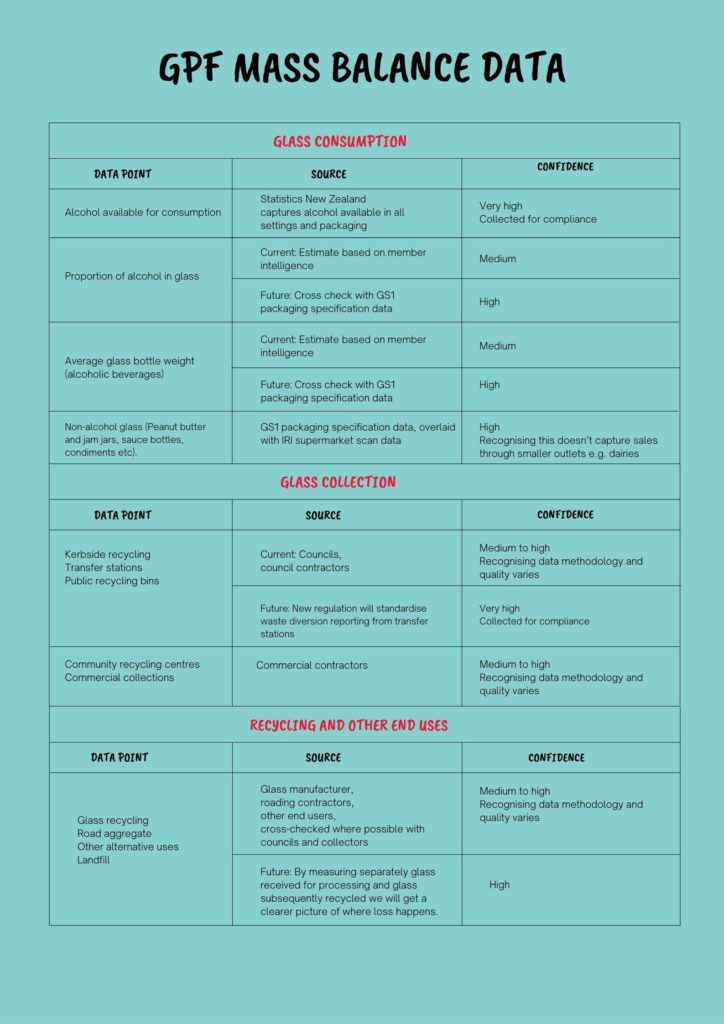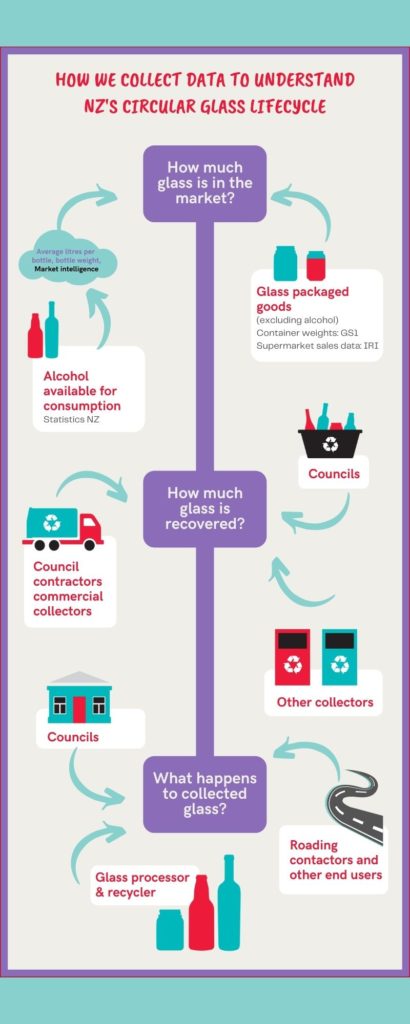
Data is at the heart of what we do
The Glass Packaging Forum is dedicated to keeping glass bottles and jars out of landfill so they can be recycled, reused or repurposed, but without data on how much glass is manufactured, imported and moved around New Zealand, and what’s happening to it, that job would be near impossible.
That’s why collecting glass market, collection network, recycling and end use data is a major part of what the GPF does. Ensuring it’s accurate and correctly interpreted is vital and over the past two years independent consultants Grant Thornton have reviewed our data methodology, given their feedback and advised on improvements.
How do we stack up?
The most recent review shows the GPF is currently using the best available data sources to produce a picture of how much glass is consumed each year, how much is recovered and what the outcomes are.
It also confirms that the best data sources are at the beginning and end of the glass lifecycle but there are some opportunities to improve knowledge at the intermediate stages.
The report highlights there is very little regulation requiring data collection. As a result, the GPF’s accredited voluntary product stewardship scheme relies on those in the supply chain, from importers and retailers to collectors and processors, to choose to provide their data, which is collected in different ways for different reasons.
By developing relationships with multiple stakeholders, using Stats NZ data, and engaging with supply chain system leaders GS1 and data analytics and integrated data provider IRI, we are continuously improving our data set and our methodology.
How do we get better data?
The biggest obstacle to achieving better data (as also highlighted by Grant Thornton) is the voluntary nature of the GPF’s product stewardship scheme and the lack of regulation around uniform waste and resource recovery data collection. The GPF isn’t alone in this. The fibre and plastic sectors also struggle to quantify just how much material is in the market and where it ends up.
According to the Grant Thornton report, a key to tackling the data shortcomings is for government regulation to require reporting in a uniform way from everyone in the supply chain.
This would form a part of any form of regulated product stewardship, but could also be developed as part of a wider reporting system for New Zealand’s waste, resource recovery and recycling systems for a range of materials.
For example, a recently introduced regulatory requirement for transfer stations to report on waste diversion from January 2022 will give us a new, highly reliable source of data – but this is just one piece of the puzzle.
Assumptions and loss
Despite the extensive work to gather data, assumptions must inevitably be made with current methodology, taking three key assumptions into account:
- What percentage of alcoholic beverage packaging is glass
- What weight this glass accounts for (average container weights)
- What level of loss is happening in the system
While accurate statistics on the number of alcoholic beverages are available from Stats NZ, the packaging type is not specified.
There is also a myriad of alcoholic beverage bottles varying in terms of shape, size and weight so an assumption must be made on an average bottle weight. We arrive at this this by cross checking with market intelligence from our members. We area also investigating whether our GS1 and IRI data sources can assist with this.
As recommended by the report, the GPF will be implementing regular formal reviews of its assumptions to ensure they reflect current industry trends as we work on not only improving them but reducing the need for them entirely.
Loss in the system is currently estimated to be 8% of recovered glass. These losses can occur in a few ways, such as broken glass sticking to labels, contamination making it impossible to recycle glass, and glass fine grinds falling through the sorting system.
While some loss is unavoidable, improving our understanding of where loss is happening and why will help us tackle the causes.
Going forward
Regulated stewardship has consistently been proven more effective than a voluntary model and the GPF will continue to work towards this goal. Through it we believe we can achieve a recovery rate of 85% or more.
New Zealand is achieving an enviable glass recovery rate, but we believe we can do better and improving data is key to this.
FAQs
What glass data does the GPF use?
We gather data from councils, collectors and end users, Stats NZ, supply chain system leaders GS1 and integrated data and analytics company IRI.

Why does the GPF need this data?
The GPF improves glass recovery through the allocation of grants as well as providing support, advice and advocacy for the glass supply chain.
Data is essential for efficiently and effectively allocating these resources. We also need to measure the effectiveness of our activities over time.
What is the current glass recovery and recycling rate?
In the 2020 reporting year, which was the one most recently reviewed by Grant Thornton, the GPF found that New Zealand has a 75% recovery rate of all glass to market of which 62% is recycled back into new glass containers.



